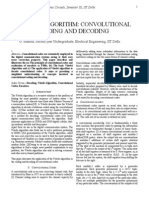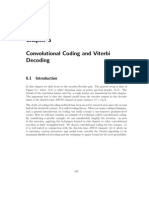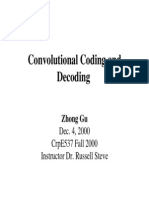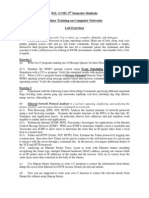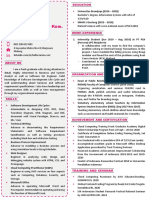Design of Convolutional Encoder and Viterbi Decoder Using MATLAB
Uploaded by
wasiullahDesign of Convolutional Encoder and Viterbi Decoder Using MATLAB
Uploaded by
wasiullahSee discussions, stats, and author profiles for this publication at: https://www.researchgate.
net/publication/339375123
Design of Convolutional Encoder and Viterbi Decoder using MATLAB
Conference Paper · January 2014
CITATIONS READS
5 3,651
1 author:
Kanchana Katta
2 PUBLICATIONS 6 CITATIONS
SEE PROFILE
Some of the authors of this publication are also working on these related projects:
coding and decoding View project
All content following this page was uploaded by Kanchana Katta on 20 February 2020.
The user has requested enhancement of the downloaded file.
INTERNATIONAL JOURNAL FOR RESEARCH IN EMERGING SCIENCE AND TECHNOLOGY, VOLUME-1, ISSUE-7, DECEMBER-2014 E-ISSN: 2349-7610
Design of Convolutional Encoder and Viterbi
Decoder using MATLAB
Kanchana Katta
Dept. of Electronics and Communication Engineering, Don Bosco College of Engineering and Technology, Assam
Don Bosco University, Guwahati, India
kanch414@gmail.com
ABSTRACT
The main aim of any communication schemes is to provide error-free data transmission .Error control coding is a method to detect
and possibly correct errors by introducing redundancy to the stream of bits to be sent to the channel. This coding has the
usefulness that it allows us to increase the rate at which information may be transmitted over a channel while maintaining a fixed
error rate. The Convolution (Channel) Encoder will add bits to the message bits to be transmitted systematically. After passing
through the channel, at the receiver end the original message sequence is obtained from the received data using Viterbi decoder. It
implements Viterbi Algorithm, which is a maximum likelihood algorithm, based on the minimum cumulative hamming distance it
decides the optimal trellis path that is most likely followed at the encoder. Convolutional encoding and Viterbi decoding are error
correction techniques widely used in Communication systems to improve the bit error rate (BER) performance. In this paper, I
present the convolution encoder and Viterbi decoder for constraint length 4 and bit rate 1/2. In addition, a Viterbi decoder is
developed in MATLAB.
Keywords — Convolution Encoder, Viterbi decoder, trellis structure
1. INTRODUCTION decoder, which is a processor that implements the
Viterbi algorithm, depend on the application in which it
Coding theory deals with transmission of data over noisy is used. Viterbi algorithm is the most resource
channels by adopting various source and channel consuming, and efficient [2].
coding/decoding schemes. The convolution codes are
widely used as forward error correction codes. The main
decoding strategy for convolutional codes is based on the
widely used Viterbi algorithm.
Convolutional encoding with Viterbi decoding is a
powerful Forward Error Correction technique that is
particularly suited to a channel in which the transmitted
signal is corrupted mainly by Additive White Gaussian
Noise (AWGN). The purpose of forward error correction
(FEC) is to improve the capacity of a channel by adding
some carefully designed redundant information to the Fig-1: Block diagram of digital communication system
data being transmitted through the channel [1]. The using convolution encoder and Viterbi Decoder
Viterbi algorithm essentially performs maximum
likelihood decoding to correct the errors in received data,
which are caused by the channel noise. Hence, minimize 2. CONVOLUTION ENCODER
the bit error rate (BER) to improve the performance.
Convolutional coding is a bit-level encoding technique.
Viterbi decoding has the advantage that it has a fixed Convolutional codes are used in applications that require
decoding time and it is well suited to hardware decoder good performance with low implementation cost. Using
implementation. The requirements for the Viterbi convolutional codes a continuous sequence of
VOLUME-1, ISSUE-7, DECEMBER-2014 COPYRIGHT © 2014 IJREST, ALL RIGHT RESERVED 10
INTERNATIONAL JOURNAL FOR RESEARCH IN EMERGING SCIENCE AND TECHNOLOGY, VOLUME-1, ISSUE-7, DECEMBER-2014 E-ISSN: 2349-7610
information bits is mapped into a continuous sequence of
encoder output bits. The encoded bits depend not only on Input bit Register State at State at Output code
current k input bits but also on past input bits. This m contents time ti time ti+1 word
mapping is highly systematic so that decoding is O1 O2
possible. As compared with the block codes,
000 00 00
convolutional codes have a larger coding gain.
1 100 00 10 1 1
Encoding of convolutional codes can be accomplished
using simple registers. The convolutional codes are 1 110 10 11 0 1
denoted by (n,k,L),where n is number of output 0 011 11 01 0 1
bits(coded),k is the number of input bits (uncoded), and
1 101 01 10 0 0
L is the code memory depth, which represents the
number of register stages. The number of the registers 1 110 10 11 0 1
used in the encoding process is called the constraint 0 011 11 01 0 1
length and it is indicated with C= (L+1).The efficiency
or data rate of a convolutional code is measured by the 0 001 01 00 1 1
ratio of the number of bits in the input (k) and the
number of bits in the output (n), therefore
Bit Rate: r = k/ n. Convolution encoding can be done using the following
methods
To convolutionally encode the data, start with L memory
elements shift register, each element holding one input a. State diagram
bit. The encoder has modulo-2 adders, and n generator b. Trellis diagram
polynomials one for each adder. The Fig-2 illustrates a
(2, 1) convolutional encoder with constraint length C=4. a) State Diagram:
One way to represent simple encoders is with a state
diagram. The state of an encoder is defined as its shift
register contents. Each new input bit results in a new
state. Therefore for one bit entering the encoder there
are 2 possible branches for every state. To make
easy for tracking the transition two different types of
line are used. Solid line ( ) represents the
transition when the input bit is '1' and dotted line (------)
represents the transition when the input bit is '0'. The
diagram shown in Fig-3 illustrates all the state transitions
that are possible for the encoder.
Fig-2: Block diagram of convolution encoder
The selection of bits is to be added (uses XOR operation)
to produce the output bits is called generator polynomial.
The generator polynomials O1 and O2 are of (111, 101)
i.e. O1 = mod2 (Reg.1 + Reg.2+ Reg.3), O2 = mod2
(Reg.1 + Reg.3).If the initial contents of the register are
all zeros, for the input bit stream m=1 1 0 1 1, the output
code word sequence obtained is 11 01 01 00 01 01 11.
TABLE- I
STATE TABLE FOR THE CONVOLUTIONALLY
ENCODING A MESSAGE SEQUENCE
Fig-3: Encoder State Diagram
VOLUME-1, ISSUE-7, DECEMBER-2014 COPYRIGHT © 2014 IJREST, ALL RIGHT RESERVED 11
INTERNATIONAL JOURNAL FOR RESEARCH IN EMERGING SCIENCE AND TECHNOLOGY, VOLUME-1, ISSUE-7, DECEMBER-2014 E-ISSN: 2349-7610
b) Trellis Diagram:
A trellis diagram is a kind of state diagram and mainly it
can be used for decoding of convolutional codes. The
detection of the original stream can be described as
finding the most probable path through the trellis.
In the trellis diagram, each node specifies an individual
state at a given time and indicates a possible pattern of
recently received data bits. Each branch indicates the
transition to a new state at the next timing cycle. When
two paths enter the same state, the one having the best
metric is chosen: this path is called the surviving path. In
the decoder the selection of surviving paths are
performed by all the states. Based on the received coded
bits we can choose the more likely path and ignore the
least likely paths. The decoding complexity can reduce Fig-5: Decoder trellis structure for C=4 and r=1/2
by ignoring the minimum likely paths.
Labeling procedure is done like this. From the received
sequence Z, we see that the code symbol received at time
t1 is 11.In order to label the decoder branches at time ti
with the appropriate hamming distance metric shown in
fig.5 encoder trellis. Here we see that a state 00 00
transition yields an output branch word of 00 , but we
received 11.Therefore ,on the decoder trellis we label the
stat 00 00 transition with Hamming distance
between them, namely 2.Looking at the encoder trellis
again ,we see that a state 00 10 transition yields an
output branch word of 11,which corresponds exactly
with the code symbols we received at time
t1.Therefore,on the decoder trellis ,we label the stat
00 10 transition with Hamming distance 0 and so on.
Fig-4: Encoder trellis structure for C=4 and Thus, the metric entered on a decoder trellis branch
r=1/2 represents the difference between what was received
and what should have been received, had the branch
word been associated with that branch been transmitted.
In effect, these metrics describe a correlation like
Fig-4 shows the encoder trellis, the branch word seen on
measure between a received branch word and each of the
the encoder trellis branches characterize the
candidate branch words. We continue labeling the
convolutional encoder. These encoder branch words are
decoder trellis branches in this way as the symbols are
the code symbols that would expected to come from the
received at each time ti. Thus the most likely (minimum
encoder output as a result of each of the state transitions.
distance) path through the trellis can be found that gives
As the code symbols are received, each branch of the the decoded output.
decoder trellis is labeled with a metric of similarity
At each time ti, there are 2C-1 states in the trellis, where
between the received code symbol and each of the
C is the constraint length, and each state can be entered
branches for that time interval. Here we can see how the
by means of two paths. Viterbi decoding consists of
decoding of the surviving branch is facilitated by having
computing the metrics for the two paths entering each
drawn the trellis branches with solid lines for the input
state and eliminating one of them. This computation is
0’s and dashed lines for the input 1’s.
done for each of the 2C-1 states or nodes at time ti, and
then the decoder moves to time ti+1 and repeats the
VOLUME-1, ISSUE-7, DECEMBER-2014 COPYRIGHT © 2014 IJREST, ALL RIGHT RESERVED 12
INTERNATIONAL JOURNAL FOR RESEARCH IN EMERGING SCIENCE AND TECHNOLOGY, VOLUME-1, ISSUE-7, DECEMBER-2014 E-ISSN: 2349-7610
process. At a given time, the winning path metric for
each state is designated as the state metric for that state
at that time.
Fig.6 from (a-e) shows the state metric comparison at
each state, the decoding process continues for all the
state transitions and to make decisions on the input data
bits by eliminating all paths but one. In the decoding
process at time t1 ,the received code symbol are 11.From
the state 00 the only possible transitions are to state 00 or
10.State 00 00 transition has the branch metric 2; state
00 10 transition has branch metric 0.
At time t2 there are two possible branches leaving each e. Survivors at t6
state metric Sa=2 and Sb=0 as shown in Fig-
Fig-6: State Metric comparison at each state
6(a).Likewise for all other states it will continue the
same process, we can see in Fig-6(e) the state metric
3. VITERBI DECODER
Sd=1 is the maximum likelihood and the path metric
In 1967 by Andrew Viterbi was proposed the Viterbi
branch word sequence is 11 01 01 10 01.
algorithm (VA) and is used to decoding a bit stream that
has been encoded using FEC code [3]. Viterbi algorithm
can be explained by a trellis diagram it requires which
comprises of minimum path and minimum distance
Calculation and retracing the path. Fig-7 shows the block
diagram of the Viterbi decoder.
It consists of following blocks
a. Branch Metric Unit (BMU)
b. Path metric calculation
c. Add Compare and Select Unit (ACS)
d. Trace Back Unit (TBU)
a. Survivors at t2 b. Survivors at t3
Fig-7: Block diagram of the Viterbi decoder
From the encoder output through the channel the BMU
receives input data and computes a metric for each state
and each input bit. There are two types of methods to
calculate the metric. The metric which is used to
calculate the
Hard-decision encoded data is the Hamming distance
and the metric is the Euclidian distance for Soft-decision
encoded data. The metric is calculated for the entire
path. The ACS unit is based on minimum distance
calculations that are obtained from the previous row
values. The Trace-back unit restore maximum likelihood
c. Survivors at t4 d. Survivors at t5 path from the decisions made by BMU. This is the final
VOLUME-1, ISSUE-7, DECEMBER-2014 COPYRIGHT © 2014 IJREST, ALL RIGHT RESERVED 13
INTERNATIONAL JOURNAL FOR RESEARCH IN EMERGING SCIENCE AND TECHNOLOGY, VOLUME-1, ISSUE-7, DECEMBER-2014 E-ISSN: 2349-7610
stage of the Viterbi decoder where the input that was Pb(ε) is plotted versus ε of the hard decision BSC model
transmitted by using the convolution encoder is once where ε=1/2erfc√ (Ec/N0) .
again retrieved [4].
For soft decisions the expression Pw (ε) =1/2erfc√
When the convolutional code bits encoded from input (wEc/N0) is used for the probability that the ML encoder
bits are modulated in to respective waveforms for makes a detour with weight w from the correct path. The
transmission over a medium that introduces attenuation, advantage of using soft decision decoding is to provide
distortion, interference,noise,etc.the received waveforms decoder with more information, which decoder then use
become uncertain" in their shapes. One of the frequently for recovering the message sequence [5]. It provides
applied criteria is the maximum-likelihood decoding better error performance than hard decision type Viterbi
(MLD) rule under which the probability of code word decoding.
estimate error is minimized subject to an equiprobable
prior on the transmitted code words. The Viterbi 4. RESULTS
decoding flow chart is given in Fig-8. Fig-9 shows that the bit error rate (BER) as a function of
the signal to noise ratio (SNR), from this graph the
performance improvement of soft decision Viterbi as
compared with hard decision Viterbi is approximately
2db.
Fig-: 9 BER graph for hard decision (HD) and soft decision
(SD) Viterbi decoder with C=4 and R=1/2.
Fig-8: Flow chart of Viterbi Decoding
5. CONCLUSION
The design of a convolutional encoder with a Viterbi decoder
that can encode a bit stream of digital information and outputs
Soft Decisions versus Hard Decisions a code word that has a capability to be transmitted to the
destination and then decoded .The encoder was designed with
The primary difference between the hard decision and constraint length 4 and rate 1/2.The Viterbi decoder design had
soft decision Viterbi algorithm is that the soft decision been driven in such a way that it would calculate the decoding
algorithm cannot use hamming distance metric because path with the minimum metric to be passed to the decoder
output port.
of its limited resolution. A distance metric with needed
resolution is the Euclidean distance. Convolutional encoder and Viterbi decoder design has been
successfully done using MATLAB and results obtained in
To compare the performance of coded binary systems on terms of BER vs SNR.The motivation of this paper is to help
the beginners to understand working of Viterbi algorithm
a AWGN channel when the decoder performs either hard those who wants to works on Viterbi decoder.
or soft decisions, the energy Ec per coded bit is fixed and
VOLUME-1, ISSUE-7, DECEMBER-2014 COPYRIGHT © 2014 IJREST, ALL RIGHT RESERVED 14
INTERNATIONAL JOURNAL FOR RESEARCH IN EMERGING SCIENCE AND TECHNOLOGY, VOLUME-1, ISSUE-7, DECEMBER-2014 E-ISSN: 2349-7610
REFERENCES
[1] Jinjin H, Zhongfeng Wang, Zhiqiang Cui, LiLi,
“Towards an Optimal Trade-off of Viterbi Decoder
Design”, Circuits and Systems, ISCAS-2009. IEEE
International Symposium, 24-27 May 2009 pp. 3030 –
3033.
[2] Swati Gupta, Rajesh Mehra,”FPGA Implementation of
Viterbi Decoder using Trace back Architecture”,
International Journal of Engineering Trends and
Technology- May to June Issue 2011.
[3] Viterbi.A.J, "Convolution codes and their Performance in
communication systems," IEEE Transaction on
Communications, vol.com-19, pp. 751 to 771, October
1971.
[4] Mahe Jabeen, Salma Khan,” Design of Convolution
Encoder and Reconfigurable Viterbi Decoder”,
International Journal of Engineering and Science ISSN:
2278-4721, Vol. 1, Issue 3(Sept2012), PP 15-21.
[5] Hiral Pujara, Pankaj Prajapati,” RTL Implementation of
ViterbiDecoder using VHDL” IOSR Journal of VLSI and
Signal Processing (IOSR-JVSP)Volume 2, Issue 1(Mar.
–Apr.2013), PP 65-71e-ISSN: 2319 –4200, p-ISSN No. :
2319 –4197
VOLUME-1, ISSUE-7, DECEMBER-2014 COPYRIGHT © 2014 IJREST, ALL RIGHT RESERVED 15
View publication stats
You might also like
- LESSON 1 - Fundamentals of Information Systems100% (1)LESSON 1 - Fundamentals of Information Systems26 pages
- Identify MAC and IP Addresses Quiz - Attempt Review100% (1)Identify MAC and IP Addresses Quiz - Attempt Review4 pages
- Design of Convolutional Encoder and Viterbi Decoder Using MATLABNo ratings yetDesign of Convolutional Encoder and Viterbi Decoder Using MATLAB6 pages
- Performance Evaluation For Convolutional Codes Using Viterbi DecodingNo ratings yetPerformance Evaluation For Convolutional Codes Using Viterbi Decoding6 pages
- FPGA Implementation of Convolutional Encoder and Hard Decision Viterbi DecoderNo ratings yetFPGA Implementation of Convolutional Encoder and Hard Decision Viterbi Decoder5 pages
- Implementation of Forward Error Correction Technique Using Convolutional Encoding With Viterbi DecodingNo ratings yetImplementation of Forward Error Correction Technique Using Convolutional Encoding With Viterbi Decoding4 pages
- Gargi Sharma Viterbi Algorithm Term Paper EEL201No ratings yetGargi Sharma Viterbi Algorithm Term Paper EEL2014 pages
- Low Constraint Length and High Performance Viterbi Decoder Using VHDLNo ratings yetLow Constraint Length and High Performance Viterbi Decoder Using VHDL7 pages
- RTL Implementation of Viterbi Decoder Using VHDL: Hiral Pujara, Pankaj PrajapatiNo ratings yetRTL Implementation of Viterbi Decoder Using VHDL: Hiral Pujara, Pankaj Prajapati7 pages
- An Asynchronous Low Power Viterbi DecoderNo ratings yetAn Asynchronous Low Power Viterbi Decoder5 pages
- FPGA Implementation of Soft Output Viterbi Algorithm Using Memoryless Hybrid Register Exchange MethodNo ratings yetFPGA Implementation of Soft Output Viterbi Algorithm Using Memoryless Hybrid Register Exchange Method9 pages
- Convolutional Coding and Viterbi DecodingNo ratings yetConvolutional Coding and Viterbi Decoding30 pages
- The Role of Forward Error Correction in Fiber-Optic SystemNo ratings yetThe Role of Forward Error Correction in Fiber-Optic System42 pages
- Convolutional Codes I Algebraic StructureNo ratings yetConvolutional Codes I Algebraic Structure19 pages
- Convolutional Coding Prepared by Vishnu.N.V GEC SreekrishnapuramNo ratings yetConvolutional Coding Prepared by Vishnu.N.V GEC Sreekrishnapuram36 pages
- Information Theory and Coding: Comparison of Hard & Soft Viterbi DecodingNo ratings yetInformation Theory and Coding: Comparison of Hard & Soft Viterbi Decoding21 pages
- A Low Power VITERBI Decoder Design With Minimum Transition Hybrid Register Exchange Processing For Wireless ApplicationsNo ratings yetA Low Power VITERBI Decoder Design With Minimum Transition Hybrid Register Exchange Processing For Wireless Applications9 pages
- Information Theory & Coding: UnderstandNo ratings yetInformation Theory & Coding: Understand126 pages
- Digital Communication Systems by Simon Haykin-105No ratings yetDigital Communication Systems by Simon Haykin-1056 pages
- A Low Power Asynchronous Viterbi Decoder Using LEDR EncodingNo ratings yetA Low Power Asynchronous Viterbi Decoder Using LEDR Encoding6 pages
- Principles of Communications: Convolutional CodesNo ratings yetPrinciples of Communications: Convolutional Codes37 pages
- Forkan EEE 520 3 Coding and Coded ModulationNo ratings yetForkan EEE 520 3 Coding and Coded Modulation28 pages
- Channel Coding For Modern Communication Systems: Presented by Yasir Mehmood (200411018)No ratings yetChannel Coding For Modern Communication Systems: Presented by Yasir Mehmood (200411018)20 pages
- ECEN 5682 Theory and Practice of Error Control CodesNo ratings yetECEN 5682 Theory and Practice of Error Control Codes56 pages
- Beyond VoIP Protocols: Understanding Voice Technology and Networking Techniques for IP TelephonyFrom EverandBeyond VoIP Protocols: Understanding Voice Technology and Networking Techniques for IP TelephonyNo ratings yet
- Unit III: 3.1 Introduction To Real Time SystemsNo ratings yetUnit III: 3.1 Introduction To Real Time Systems36 pages
- SAP Analytics Cloud - Acquire Data From JDBC ConnectionNo ratings yetSAP Analytics Cloud - Acquire Data From JDBC Connection13 pages
- Concurrent Programming in Java Design Principles ANo ratings yetConcurrent Programming in Java Design Principles A216 pages
- Data Recovery Logical & Physicalshort Course Content Chapter WiseNo ratings yetData Recovery Logical & Physicalshort Course Content Chapter Wise4 pages
- Information Technology Resume Sample - Windsor OliveNo ratings yetInformation Technology Resume Sample - Windsor Olive2 pages
- Unit 1: Introduction To Software Engineering: Anju K. Kakkad Asst. Professor Scholl of Engineering RK-University-RajkotNo ratings yetUnit 1: Introduction To Software Engineering: Anju K. Kakkad Asst. Professor Scholl of Engineering RK-University-Rajkot39 pages
- Awareness and Preparedness of Internet Users To Deal With Threats of Cyber Crime at Barangay Kibudoc, Matalam, CotabatoNo ratings yetAwareness and Preparedness of Internet Users To Deal With Threats of Cyber Crime at Barangay Kibudoc, Matalam, Cotabato34 pages
- Wiring & Settings of Hand Scanner For PTL & Feedline: Falcon Autotech Pvt. Ltd. - ConfidentialNo ratings yetWiring & Settings of Hand Scanner For PTL & Feedline: Falcon Autotech Pvt. Ltd. - Confidential21 pages
- What Is An Endpoint - Microsoft SecurityNo ratings yetWhat Is An Endpoint - Microsoft Security4 pages
- This Study Resource Was: Automation Anywhere Certification Mcqs With AnswersNo ratings yetThis Study Resource Was: Automation Anywhere Certification Mcqs With Answers7 pages
- Rs-232 Protocol Commands: Recordex SimplicitytouchNo ratings yetRs-232 Protocol Commands: Recordex Simplicitytouch5 pages
- Network Security Checklist: General Security Planning TipsNo ratings yetNetwork Security Checklist: General Security Planning Tips2 pages
- E-Security:: Keamanan Teknologi InformasiNo ratings yetE-Security:: Keamanan Teknologi Informasi20 pages
- Dokumen - Tips Oca Java Se 8 Exam Chapter 3 Core Java ApisNo ratings yetDokumen - Tips Oca Java Se 8 Exam Chapter 3 Core Java Apis66 pages
- 1 English For Information Technology Elementa-44-51 NETWORK SYSTEMNo ratings yet1 English For Information Technology Elementa-44-51 NETWORK SYSTEM8 pages
- Identify MAC and IP Addresses Quiz - Attempt ReviewIdentify MAC and IP Addresses Quiz - Attempt Review
- Design of Convolutional Encoder and Viterbi Decoder Using MATLABDesign of Convolutional Encoder and Viterbi Decoder Using MATLAB
- Performance Evaluation For Convolutional Codes Using Viterbi DecodingPerformance Evaluation For Convolutional Codes Using Viterbi Decoding
- FPGA Implementation of Convolutional Encoder and Hard Decision Viterbi DecoderFPGA Implementation of Convolutional Encoder and Hard Decision Viterbi Decoder
- Implementation of Forward Error Correction Technique Using Convolutional Encoding With Viterbi DecodingImplementation of Forward Error Correction Technique Using Convolutional Encoding With Viterbi Decoding
- Low Constraint Length and High Performance Viterbi Decoder Using VHDLLow Constraint Length and High Performance Viterbi Decoder Using VHDL
- RTL Implementation of Viterbi Decoder Using VHDL: Hiral Pujara, Pankaj PrajapatiRTL Implementation of Viterbi Decoder Using VHDL: Hiral Pujara, Pankaj Prajapati
- FPGA Implementation of Soft Output Viterbi Algorithm Using Memoryless Hybrid Register Exchange MethodFPGA Implementation of Soft Output Viterbi Algorithm Using Memoryless Hybrid Register Exchange Method
- The Role of Forward Error Correction in Fiber-Optic SystemThe Role of Forward Error Correction in Fiber-Optic System
- Convolutional Coding Prepared by Vishnu.N.V GEC SreekrishnapuramConvolutional Coding Prepared by Vishnu.N.V GEC Sreekrishnapuram
- Information Theory and Coding: Comparison of Hard & Soft Viterbi DecodingInformation Theory and Coding: Comparison of Hard & Soft Viterbi Decoding
- A Low Power VITERBI Decoder Design With Minimum Transition Hybrid Register Exchange Processing For Wireless ApplicationsA Low Power VITERBI Decoder Design With Minimum Transition Hybrid Register Exchange Processing For Wireless Applications
- A Low Power Asynchronous Viterbi Decoder Using LEDR EncodingA Low Power Asynchronous Viterbi Decoder Using LEDR Encoding
- Channel Coding For Modern Communication Systems: Presented by Yasir Mehmood (200411018)Channel Coding For Modern Communication Systems: Presented by Yasir Mehmood (200411018)
- ECEN 5682 Theory and Practice of Error Control CodesECEN 5682 Theory and Practice of Error Control Codes
- Error-Correction on Non-Standard Communication ChannelsFrom EverandError-Correction on Non-Standard Communication Channels
- Beyond VoIP Protocols: Understanding Voice Technology and Networking Techniques for IP TelephonyFrom EverandBeyond VoIP Protocols: Understanding Voice Technology and Networking Techniques for IP Telephony
- Digital Communications 1: Source and Channel CodingFrom EverandDigital Communications 1: Source and Channel Coding
- SAP Analytics Cloud - Acquire Data From JDBC ConnectionSAP Analytics Cloud - Acquire Data From JDBC Connection
- Concurrent Programming in Java Design Principles AConcurrent Programming in Java Design Principles A
- Data Recovery Logical & Physicalshort Course Content Chapter WiseData Recovery Logical & Physicalshort Course Content Chapter Wise
- Information Technology Resume Sample - Windsor OliveInformation Technology Resume Sample - Windsor Olive
- Unit 1: Introduction To Software Engineering: Anju K. Kakkad Asst. Professor Scholl of Engineering RK-University-RajkotUnit 1: Introduction To Software Engineering: Anju K. Kakkad Asst. Professor Scholl of Engineering RK-University-Rajkot
- Awareness and Preparedness of Internet Users To Deal With Threats of Cyber Crime at Barangay Kibudoc, Matalam, CotabatoAwareness and Preparedness of Internet Users To Deal With Threats of Cyber Crime at Barangay Kibudoc, Matalam, Cotabato
- Wiring & Settings of Hand Scanner For PTL & Feedline: Falcon Autotech Pvt. Ltd. - ConfidentialWiring & Settings of Hand Scanner For PTL & Feedline: Falcon Autotech Pvt. Ltd. - Confidential
- This Study Resource Was: Automation Anywhere Certification Mcqs With AnswersThis Study Resource Was: Automation Anywhere Certification Mcqs With Answers
- Rs-232 Protocol Commands: Recordex SimplicitytouchRs-232 Protocol Commands: Recordex Simplicitytouch
- Network Security Checklist: General Security Planning TipsNetwork Security Checklist: General Security Planning Tips
- Dokumen - Tips Oca Java Se 8 Exam Chapter 3 Core Java ApisDokumen - Tips Oca Java Se 8 Exam Chapter 3 Core Java Apis
- 1 English For Information Technology Elementa-44-51 NETWORK SYSTEM1 English For Information Technology Elementa-44-51 NETWORK SYSTEM










